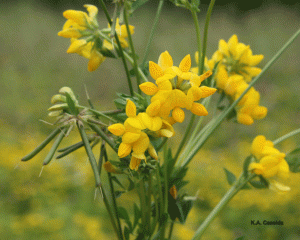Building a Better Birdsfoot Trefoil
Birdsfoot trefoil is a high-quality forage legume that is well-adapted throughout Michigan, where there once was a thriving birdsfoot trefoil seed industry. Birdsfoot trefoil has a number of beneficial characteristics. It does not cause pasture bloat, and will grow on wetter, more acid soils than many other legumes, though it does best on good soils. It also contains condensed tannins (CT), a type of plant secondary compound with many positive attributes. It is the condensed tannins that give trefoil its bloat-free characteristic. The CT in birdsfoot trefoil is also associated with improved forage protein utilization in grazing cattle and with reduced N losses in silage fermentation. All of these effects occur because of the affinity of CT for reversible binding to plant proteins. In addition,  CT in birdsfoot trefoil have recently been linked to alleviation of fescue toxicosis when grazed in mixed tall fescue/birdsfoot trefoil pastures and have an anthelmintic effect on gastrointestinal parasites in grazing sheep and goats.
CT in birdsfoot trefoil have recently been linked to alleviation of fescue toxicosis when grazed in mixed tall fescue/birdsfoot trefoil pastures and have an anthelmintic effect on gastrointestinal parasites in grazing sheep and goats.
There is a great deal of genetic variation for CT concentration in birdsfoot trefoil, but most commercially available varieties have relatively low CT concentrations. Trefoil is difficult to establish compared to other legumes and exhibits poor stand persistence in many regions of the USA. It is also an unreliable seed producer, which contributes to high seed prices compared to other common legumes. Nevertheless, the great potential of this legume to address multiple key issues makes it worthwhile to expend research effort on solving the problems.
In 2013, MSU was invited to participate in a project to develop a new birdsfoot trefoil variety with high condensed tannin concentrations and wide adaptation across the USA. Universities participating in the project include the lead institution Auburn University (AL), and University of Idaho (ID), University of Kentucky (KY), Michigan State University, University of Missouri (MO), Utah State University (UT), and West Virginia University (WV). The grant entitled “Increasing Legume Grazing for Higher Beef Gain on Pastures: An Improved High-Tannin Birdsfoot Trefoil Cultivar with Trans-Regional Potential” was funded by USDA-NIFA, and we obtained additional funding for the Michigan component from Project GREEEN.
Publications
Turner, K.E., K.A. Cassida, H.N. Zerby, and M.A. Brown. 2014. Carcass and meat quality when meat-goat kids were finished on chicory, birdsfoot trefoil, or red clover pastures. Meat Sci. (in revision)
Grabber, J.H., W.K. Coblentz, H. Riday, T.C. Griggs, D.H. Min, J.W. MacAdam, and K.A. Cassida. 2014. Protein and dry matter degradability of European- and Mediterranean-derived birdsfoot trefoil cultivars grown in the colder continental USA. Agron. J. (in review)
Grabber, J.H., H. Riday, K.A. Cassida, T.C. Griggs, D.H. Min, and J.W. MacAdam. 2014. Yield, relative maturity, and forage quality of European and Mediterranean-derived birdsfoot trefoil genotypes in the colder continental United States. Crop Sci. 54:1893-1901.
Cassida, K.A., T.S. Griffin, J. Rodriguez, S.C. Patching, O.B. Hesterman, and S.R. Rust. 2000. Protein degradability and forage quality in maturing alfalfa, red clover, and birdsfoot trefoil. Crop Sci. 40:209-215.

